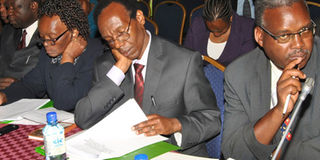Curriculum review process begins

PHOTO | FILE Delegates at a workshop on “Curriculum Review and Support Material” at the Kenya Institute of Curriculum Development last year.
What you need to know:
- Existing syllabus content and structures outdated
- The new curriculum will be implemented in 2016 in phases, starting with lower primary, Standard Four and Form Four.
A process to review the curriculum and reshape the country’s education begins this week with a consultative meeting to review tools for gathering the public’s views on what should be taught in schools.
The new curriculum will be implemented in 2016 in phases, starting with lower primary, Standard Four and Form Four.
Reviewing the curriculum will involve examining the relevance and depth of content currently taught, the number of subjects offered, as well as the mode of examining and certifying them. It will also define the way subjects are clustered, especially in high schools where there are compulsory and optional disciplines.
At the heart of the matter is the concern that the current curriculum has become obsolete, having been in use for more than a decade. According to internationally accepted best practice, a curriculum should be reviewed every five years to weed out concepts and skills that have outlived their time, and introduce emerging ones.
The director of the Kenya Institute of Curriculum Development (KICD), Dr Lydiah Nzomo, says the first step in reviewing the curriculum is conducting a needs-assessment to gauge what the public thinks about the current curriculum.
To carry out the needs-assessments, tools have to be developed for gathering and collating data and information and agreed upon to ensure legitimacy.
Thus, a consensus building meeting will take place next Wednesday at KICD and will be presided over by Education Cabinet Secretary Jacob Kaimenyi.
“The needs assessment will provide the data that will reveal the status of education, and give insights into the reforms required,” said Dr Nzomo.
She added: “The assessment will help establish the societal needs to be addressed in the curriculum, as well as determine the desired skills, suitable competencies, modes of testing, preferred topics, pedagogical approaches and learning experiences.”
An evaluation of the curriculum conducted in 2009 by the institute established that it had many gaps and required a review. But nothing was done at the time.
If there were gaps then, they have widened in the past five years, underscoring the urgency of the review. For example, the content of subjects like Social Studies (primary) or History and Government (high school) is out of sync with current realities.
For instance, the Constitution of Kenya (2010) created a new form of governance structure comprising national and county governments and a two-tier Parliament, that is not taught.
At the regional level, institutions like the East African Community have expanded to include Rwanda and Burundi, and the terms of engagement changed. Such changes ought to be included in the syllabus.
In English and Kiswahili, the current high school syllabus provides for integration of language with literature, which undermines mastery of the subjects.
Moreover, the current curriculum has been criticised for putting too much premium on examinations at the expense of co-curricular activities, thus creating a generation of textbook tigers rather than skilled performers.




